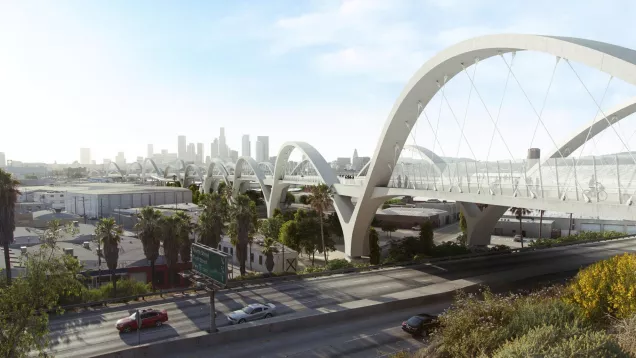
No other Los Angeles landmark has burnished itself in popular culture quite like the Sixth Street Viaduct. The backdrop for countless car chases in films like “Grease” and “Terminator 2”, the 3,500-foot bridge was considered state-of-the-art when it was built in 1932. So why did the Bureau of Engineering have to demolish this icon just 84 years later?
It turns out, the bridge suffered from “concrete cancer”. Connecting the communities of Boyle Heights and the Arts District in downtown Los Angeles, the Sixth Street Viaduct was built with concrete produced on-site using an aggregate from a different source than for the thirteen other bridges spanning the Los Angeles River. The aggregate reacted to the alkaline content of the cement, causing a condition known as Alkali Silica Reaction, and cracks began forming just twenty years later. Engineering tried to stop the deterioration, but a seismic study concluded that the City had no choice but to demolish.
While some called on Engineering to replicate the original design, others saw the demolition as a chance to erect a design more commensurate with a revitalized downtown and a vastly different transportation and environmental landscape. The new bridge could redefine the public’s relationship with infrastructure much as the original had.
Engineering pushed the envelope in other ways, opting to use a project delivery method known as the Construction Manager/General Contractor (CMGC), the first ever for a City project. Under CMGC, the contractor provides feedback during the design phase before construction. Early collaboration between designer and builder would not only foster a more innovative design, it would mitigate construction risks that could potentially lead to costly delays.
Freed from past precedent, Engineering launched an international design competition. The winning design, dubbed the “Ribbon of Light”, pays homage to the original pair of double arches with ten pairs of undulating arches. The new bridge is also on track to achieve a Platinum rating under the Envision™ sustainable infrastructure rating system. For example, though the replacement will be twice as wide, it will use just half the concrete. The Bureau of Street Lighting also partnered with designers to develop the LED lighting in the concrete barrier rail, eliminating the need for streetlight poles while reducing light pollution.
Demolition was completed in 2016 under the watchful eye of Bureau of Contract Administration inspectors, who have also been overseeing the foundation work. Keeping the $482 million project on track for completion in 2020, ConAd has been a vital partner in the CMGC collaboration.
The project team encourages project owners - that is, members of the public - to engage in the process too. Stairs and a helical ramp structure will connect the viaduct to ground level, giving visitors extensive pedestrian and bike access to 12 acres of park space that will ultimately connect to the LA River - a separate $13 million project known as the Sixth Street Park, Arts, River and Connectivity Improvements Project (Sixth Street PARC). All are welcome to weigh in on how to develop the open space by taking a survey, participating in focus groups or taking a tour. Follow our progress here.